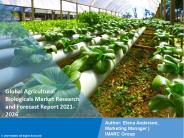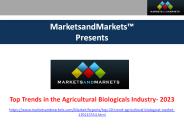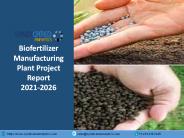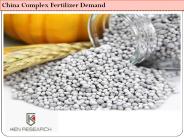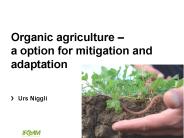Biological Organic Fertilizers Market PowerPoint PPT Presentations
All Time
Recommended
The 'Global and Chinese Biological Organic Fertilizers Industry, 2013-2023 Market Research Report' is a professional and in-depth study on the current state of the global Biological Organic Fertilizers industry with a focus on the Chinese market.
| PowerPoint PPT presentation | free to download
This report focuses on Biological Organic Fertilizers volume and value at the global level, regional level and company level.
| PowerPoint PPT presentation | free to download
According to the latest report by Renub Research, titled “Biological Organic Fertilizers Market Global Forecast 2021-2027, Industry Trends, Share, Insight, Impact of COVID-19, Opportunity Company Analysis” the Global Biological Organic Fertilizers Market will be US$ 3.1 Billion by 2027. Nowadays, in developing intensive agriculture globally application of chemical fertilizers is the most adopted system. However, the continuous long-term use of chemical fertilizer has led to many unexpected effects. Hence, biological organic fertilizers in recent years have been considered an alternative source for soil, water, and crop-contaminating chemical fertilizers to have the potential to enhance soil productivity and plant growth in a sustainable agriculture worldwide.
| PowerPoint PPT presentation | free to download
Increasing consumer awareness pertaining to harmful effects of synthetic & chemical fertilizers, pesticides and drugs will provide positive outlook for industry size. Growing consumer base for non-synthetic food, beverages, personal care and pharmaceutical products has enhanced the organic fertilizers demand. Rising awareness about health & safety particularly in urban population will support industry growth.
| PowerPoint PPT presentation | free to download
Increasing consumer awareness pertaining to harmful effects of synthetic & chemical fertilizers, pesticides and drugs will provide positive outlook for industry size. Growing consumer base for non-synthetic food, beverages, personal care and pharmaceutical products has enhanced the organic fertilizers demand. Rising awareness about health & safety particularly in urban population will support industry growth
| PowerPoint PPT presentation | free to download
An outlook on Organic Fertilizers Market growth is presented in this latest research report that reviews industry growth drivers, trends, regional factors & companies as well as provides forecasts for next few years.
| PowerPoint PPT presentation | free to download
The Global Agriculture Biologicals Market report 2018-2024, has been prepared By Axiom Market Research & Consulting, the research study provides complete qualitative and quantitative valuation in-depth analysis of the industry value chain focusing on the peer and parent markets of agriculture biologicals, such as agriculture market, organic fertilizers market etc.
| PowerPoint PPT presentation | free to download
According to Cognitive Market Research, The Global Organic Cotton market will be USD 0.528 billion in 2023 and grow at a compound annual growth rate (CAGR) of 42.00%from 2023 to 2030.
| PowerPoint PPT presentation | free to download
According to Cognitive Market Research, the global Organic Vegetable Seeds market size is USD 3215.2 million in 2024 and will expand at a compound annual growth rate (CAGR) of 13.40% from 2024 to 2031.
| PowerPoint PPT presentation | free to download
According to the latest research report by IMARC Group, The global agricultural biologicals market size reached US$ 14.3 Billion in 2023. Looking forward, IMARC Group expects the market to reach US$ 44.6 Billion by 2032, exhibiting a growth rate (CAGR) of 13.1% during 2024-2032. More Info:- https://www.imarcgroup.com/agricultural-biologicals-market
| PowerPoint PPT presentation | free to download
BRIC Organic Baby Food Market, By Product Type (Ready to Feed, Prepared, Milk Formula, Dried, Others), By Distribution Channel (Supermarket, Specialty Outlet, Drug Stores & Pharmacies, Internet, Others), By Countries (Brazil, Russia, India, China) - Size, Share, Outlook, and Opportunity Analysis, 2020 – 2027
| PowerPoint PPT presentation | free to download
According to the latest research report by IMARC Group, The Middle East organic food market size is projected to exhibit a growth rate (CAGR) of 5.50% during 2024-2032. More Info:- https://www.imarcgroup.com/middle-east-organic-food-market
| PowerPoint PPT presentation | free to download
The biological seed treatment market is projected to reach USD 1.7 billion by 2025, and it was valued at USD 0.9 billion in 2020. It is expected to grow with CAGR of 11.9%.
| PowerPoint PPT presentation | free to download
The agricultural biologicals market size is expected to grow from USD 16.7 billion in 2024 to USD 31.8 billion by 2029, with a compound annual growth rate (CAGR) of 13.8% during this period.
| PowerPoint PPT presentation | free to download
Organic Fertilizers Market Information: by Source (Minerals, Plants, and Animals), by Crop (Oilseeds & Pulses, Cereals & Grains, Fruits & Vegetables, and others), by Certifications (100% Organic, and 95% Organic), By Form (Dry, and Liquid), and by Regions - Forecast till 2030
| PowerPoint PPT presentation | free to download
The biological seed treatment market is projected to reach USD 1.7 billion by 2025, and it was valued at USD 0.9 billion in 2020. It is expected to grow with CAGR of 11.9%.
| PowerPoint PPT presentation | free to download
Read here the latest updates on the INDUSTRIAL DRYER MARKET ANALYSIS published by CMI team
| PowerPoint PPT presentation | free to view
Organic Farming Market focuses on the global Organic Farming status, future forecast, growth opportunity, key market and key players
| PowerPoint PPT presentation | free to download
Read here the latest updates on the Cytotoxic Drugs Contract Manufacturing Market published by the CMI team.
| PowerPoint PPT presentation | free to download
Looking forward, the agricultural biologicals market value is projected to reach a strong growth during the forecast period (2021-2026). More info:- https://www.imarcgroup.com/agricultural-biologicals-market
| PowerPoint PPT presentation | free to download
According to the latest research report by IMARC Group, The global agricultural biologicals market size reached US$ 12.4 Billion in 2022. Looking forward, IMARC Group expects the market to reach US$ 28.3 Billion by 2028, exhibiting a growth rate (CAGR) of 15% during 2023-2028. More Info:- https://www.imarcgroup.com/agricultural-biologicals-market
| PowerPoint PPT presentation | free to download
In 2022, the global revenue generated by the proteomics market reached approximately US$ 30.8 billion, and it is anticipated to exhibit a robust compound annual growth rate (CAGR) of 17.6%, projecting a valuation of US$ 181.5 billion by the conclusion of 2033. According to the evaluation conducted by Persistence Market Research, the reagents and kits segment is poised to dominate with the highest market value, reaching US$ 18.4 billion by 2023. Contributing to around 6.0% of the total revenue in the global omics market, valued at approximately US$ 514.3 billion by the close of 2022, sales in the proteomics market demonstrate a substantial presence. Over the past eight years, from 2014 to 2022, the global proteomics market has exhibited a historic CAGR of 15.5%.
| PowerPoint PPT presentation | free to download
Looking forward, the agricultural biologicals market value is projected to reach a strong growth during the forecast period (2022-2027). More info:- https://www.imarcgroup.com/agricultural-biologicals-market
| PowerPoint PPT presentation | free to download
Animal Raw material product type of Organic Fertilizers market is projected to be the leading segment of the overall market during the forecast period. Dry form is projected to be leading availability form of the Organic Fertilizers during forecast period
| PowerPoint PPT presentation | free to download
Organic farming is a method that involves growing and nurturing crops with the use of biological materials preventing the use of synthetic based fertilizers and pesticides. Also, the use of genetically modified organisms is not permitted. Organic farming systems have a great potential to provide the world with healthy, high-quality food.
| PowerPoint PPT presentation | free to download
Biochar Market is forecast to reach $3.2 million by 2025, after growing at a CAGR of 13.6% during 2020-2025. Rising global demand for the product in organic farming has been a major factor influencing growth.
| PowerPoint PPT presentation | free to download
Download Sample of Research @ http://tinyurl.com/h8ux6vh The report covers the present scenario and the growth prospects of the organic food and beverage market in Europe for 2016-2020. To calculate the market size, the report has taken into consideration the revenue generated from the sales of packaged organic-labeled foods and beverages sold through retail stores, such as supermarkets, hypermarkets, specialty stores, online stores, and other grocery stores.
| PowerPoint PPT presentation | free to download
The Agricultural Biologicals market players functional in the industry are BASF SE, Bayer Cropscience AG, The DOW Chemical Company, Syngenta, Agrinos AS, Marrone Bio Innovations Inc. and Valent BioScience Corporation
| PowerPoint PPT presentation | free to download
Biofertilizers Market report categorizes the Global Market by Form, Crop Type, Type, Mode of Application, & by Geography. Get detail insights on Covid-19 Impact on Biofertilizers Market, get report today
| PowerPoint PPT presentation | free to download
[177 Pages Report] The Agricultural Biologicals Market was valued at USD 6.00 Billion in 2016 and is projected to reach 14.65 Billion by 2023, growing at a CAGR of 13.80% from 2017. The market is driven by factors such as the growth prospects of organic food, a favorable framework for agriculture, and the impact of these pesticides in achieving sustainable agriculture. Read more: https://www.marketsandmarkets.com/Market-Reports/top-10-trend-agricultural-biological-market-139215554.html
| PowerPoint PPT presentation | free to download
Organics Toolbox: Local Compost Market Development Progress and Promise
| PowerPoint PPT presentation | free to view
Global Agricultural Biologicals Market size is expected to reach USD 18.3 Bn by 2027 from USD 8.4 Bn in 2020, with a CAGR of 11.8% during the forecast period.
| PowerPoint PPT presentation | free to download
The growth of the agricultural biologicals market is driven by factors such as increasing demand for organic products, rising world population, reduced chemical hazards, and easier residue management. Moreover, emerging economies such as India and China, along with Japan, are creating growth opportunities for the agricultural biologicals market in the Asia-Pacific region. Browse full report @ http://goo.gl/GZIQvv
| PowerPoint PPT presentation | free to download
Biofertilizers Market report categorizes the global market by Form, Crop Type, Type, Mode of Application, & by Geography. Covid-19 Impact on Biofertilizers Market.
| PowerPoint PPT presentation | free to download
Agricultural Biologicals Market has been segmented on the basis of type, source, mode of application, application, and region. Based on type, the global agricultural biologicals market has been segregated into biopesticides, biofertilizers, bio-stimulants, and others. By source, the global agricultural biologicals market has been categorized as microbials, biochemicals, and biorationals. On the basis of application, the global agricultural biologicals market has been segregated into foliar spray, soil treatment, and seed treatment. By application, the global agricultural biologicals market has been divided into cereals and grains, oilseeds and pulses, fruits and vegetables, cash crops and others. The global agricultural biologicals market has been analyzed across five key regions, namely, Asia-Pacific, North America, Latin America, Europe, and the Middle East & Africa. Get Free Sample Request @ https://www.marketresearchfuture.com/sample_request/6629
| PowerPoint PPT presentation | free to download
View free report synopsis, Please click link @ http://goo.gl/7m4GNF . "Europe dominated the market and is also projected to be the fastest growing market during the forecast period” It is because of the adoption of modern agricultural technology and organic farming. Most of the land is majorly utilized by the European population for agriculture. Therefore, agriculture becomes the main occupation in European countries, such as France, Germany, and the U.K. Increasing land degradation and rising productivity demand of high-quality crops are exerting immense pressure on the leading agricultural produce-exporting countries.
| PowerPoint PPT presentation | free to download
Future Market Insights (FMI), in its latest publication, outlines the future trajectory of the global nucleic acid isolation and purification market through 2029. According to the report, worldwide sales of nucleic acid isolation and purification kits were valued at ~US$ 830 million in 2018, and are estimated to register a Y-o-Y growth of ~4% in 2019.
| PowerPoint PPT presentation | free to view
Want food produced the good the old-fashioned way, the sustainable way, the ... sales typically increase when food recalls are announced; perceived as safer. ...
| PowerPoint PPT presentation | free to view
Due to massive growth of human population, changes in global climate, the emergence of novel/more virulent pathogens, there has been an increase in the demand for chemical-free and sustainably produced food products. Biological control market plays its role for the same. The use of bacterium-based biological control agents (BCAs) will be supportive if used as a part of an integrated management system.
| PowerPoint PPT presentation | free to download
Due to massive growth of human population, changes in global climate, the emergence of novel/more virulent pathogens, there has been an increase in the demand for chemical-free and sustainably produced food products. Biological control market plays its role for the same. The use of bacterium-based biological control agents (BCAs) will be supportive if used as a part of an integrated management system.
| PowerPoint PPT presentation | free to download
The rising consumer concerns toward the detrimental impact of chemical-based fertilizers both on the environment and human health, are primarily driving the demand for organic fertilizers. Moreover, the launch of numerous government initiatives and training programs for educating farmers about the associated benefits of organic fertilizers is also propelling the market growth.
| PowerPoint PPT presentation | free to download
The rising environmental concerns towards the negative impact of chemical-based fertilizers are primarily driving the global organic fertilizer market. Furthermore, the introduction of advanced farming techniques and the growing utilization of bio-fertilizers are also contributing to the market growth. Additionally, the implementation of stringent government regulations restricting the use of synthetic fertilizers is acting as another significant growth-inducing factor. Besides this, the increasing demand for organic food crops due to growing consumer health-consciousness is expected to further propel the market growth in the coming years. Read more: www.syndicatedanalytics.com/organic-fertilizer-manufacturing-plant-project-report
| PowerPoint PPT presentation | free to download
Turf Protection Market
| PowerPoint PPT presentation | free to download
In the vast landscape of micronutrients, zinc stands out as a critical element for various biological functions in both plants and animals. Zinc plays a pivotal role in enzymatic reactions, protein synthesis, and immune system regulation. However, ensuring adequate zinc levels in organisms can be challenging due to its low bioavailability in traditional forms. The global zinc methionine chelates market is forecast to expand at a CAGR of 7.1% and thereby increase from a value of US$59.6 Bn in 2023, to US$96.3 Bn by the end of 2030.
| PowerPoint PPT presentation | free to download
The wood vinegar market, in terms of value, is projected to reach around USD 6.7 Million by 2022, at a CAGR of 7.2% from 2016 to 2022. The wood vinegar market has grown steadily in the recent years. It has a significant impact on agriculture as a bio-based agricultural input, in terms of increasing the yield, quality, and nutrition-level of the produced crops, and this has led to its high demand across the world. This is due to the need for food products that are required to be safe for consumption as busy lifestyles of people, especially in the developed regions, opt for convenience food products. However, health conscious people nowadays are demanding for organic food products which are produced using organic agricultural practices and organic agricultural inputs and this has led to the increase in use of biopesticides and bio-based fertilizers, such as wood vinegar in agriculture. The market, by region, has been segmented into North America, Europe, Asia-Pacific, and RoW.
| PowerPoint PPT presentation | free to download
Organic Farming - eacademic.ju.edu.jo ... Introduction
| PowerPoint PPT presentation | free to download
BioControl Agents (BCAs) are beneficial organisms that assist farmers in pest control and plant growth. BCA is one of the emerging trends in the crop protection industry supporting the wider trend of non-chemical pest control. Due to massive growth of human population, changes in global climate, the emergence of novel/more virulent pathogens, there has been an increase in the demand for chemical-free and sustainably produced food products. Biological control market plays its role for the same. The use of bacterium-based biological control agents (BCAs) will be supportive if used as a part of an integrated management system.
| PowerPoint PPT presentation | free to download
ORGANIC FARMING WHAT IS ORGANIC FARMING Organic agriculture (Farming) is a way of agricultural production that no chemical input is used, each step ,from production ...
| PowerPoint PPT presentation | free to view
Boosts local economy. Healthier for customers and me ... 2001 Local natural foods market and an organic producers cooperative. 2002 Local restaurants ...
| PowerPoint PPT presentation | free to view
BioControl Agents (BCAs) are beneficial organisms that assist farmers in pest control and plant growth. BCA is one of the emerging trends in the crop protection industry supporting the wider trend of non-chemical pest control. Due to massive growth of human population, changes in global climate, the emergence of novel/more virulent pathogens, there has been an increase in the demand for chemical-free and sustainably produced food products. Biological control market plays its role for the same. The use of bacterium-based biological control agents (BCAs) will be supportive if used as a part of an integrated management system.
| PowerPoint PPT presentation | free to download
The growing awareness about the negative environmental impact of synthetic fertilizers, pertaining to the contamination of food chain and soil pollution, is driving the biofertilizer market. Furthermore, due to rising prices of artificial stimulants, several farmers are switching to biofertilizers that also decompose organic residue, which is also augmenting the market growth. Read more: https://www.syndicatedanalytics.com/biofertilizer-manufacturing-plant-project-report
| PowerPoint PPT presentation | free to download
BioControl Agents (BCAs) are beneficial organisms that assist farmers in pest control and plant growth. BCA is one of the emerging trends in the crop protection industry supporting the wider trend of non-chemical pest control. Due to massive growth of human population, changes in global climate, the emergence of novel/more virulent pathogens, there has been an increase in the demand for chemical-free and sustainably produced food products. Biological control market plays its role for the same. The use of bacterium-based biological control agents (BCAs) will be supportive if used as a part of an integrated management system.
| PowerPoint PPT presentation | free to download
BioControl Agents (BCAs) are beneficial organisms that assist farmers in pest control and plant growth. BCA is one of the emerging trends in the crop protection industry supporting the wider trend of non-chemical pest control. Due to massive growth of human population, changes in global climate, the emergence of novel/more virulent pathogens, there has been an increase in the demand for chemical-free and sustainably produced food products. Biological control market plays its role for the same. The use of bacterium-based biological control agents (BCAs) will be supportive if used as a part of an integrated management system.
| PowerPoint PPT presentation | free to download
Ken Research in its latest study, China Complex (NPK) Fertilizer Market Outlook to 2022 – Expected Replacement from Straight Chemical Fertilizers to Complex Fertilizers suggests that Kingenta, Hubei Xinyangfeng, China XLX Fertilizers and Sino-Arab Chemical Fertilizers will remain the major players in this space in China. However, these major players will witness rising competition from other existing and new entrants launching cheaper products in the market.
| PowerPoint PPT presentation | free to download
Organic farming delivers many additional societal benefits. Organic farming is a viable solution for small holder farmers in developing countrie Consequences ...
| PowerPoint PPT presentation | free to download
Organic humic acid is a fertilizer that feeds plants the way nature intended. Unlike nitrogen and phosphorus, which burn out quickly and need to be continually replenished, humic acid stays active in the soil for years. Humic acid boosts nutrient uptake and root growth, while also improving soil structure, preventing compaction and erosion. It can even help plants withstand drought and heat stress
| PowerPoint PPT presentation | free to download




















